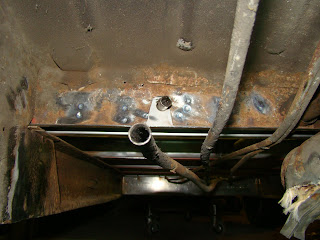In between sorting the rear end, the disc break mod, drawing up parts to be machined and collecting the bits needed to finish off the panel work, I've been trying out my new toy.
I managed to get my 13Kw as a used display model for £380 from eBay but having to wire up a 32amp socket, plugs and cables so it would work cost me an extra £50 on top.
Once I was all wired up and running I started practicing straight away, like a child with a hot and dangerous Christmas present. Reading the instructions carefully I set up the rod gap thickness to the metal, adjusted the required pressure and set the welder to the required power and material thickness, pulled the trigger and sparks went flying. As the instructions said to leave the rods closed for a few seconds to cool the weld and then release, behold my first spot weld, easy.... I thought.
 Although there are still a few variables, power, pressure, gap and timing the welding is pretty easy, apart from the weight of the welder when as you lie on your back and hold it up to the van above you, and also that the material is spotlessly clean.
Although there are still a few variables, power, pressure, gap and timing the welding is pretty easy, apart from the weight of the welder when as you lie on your back and hold it up to the van above you, and also that the material is spotlessly clean.
The instructions did not mention that you have to set the gap with the trigger set just before the pressure spring starts to work, this meant I started spot welding the lower bulkhead to the forward cross support with no pressure reacting on the metal, and what this does is spark erode the material away, (burn a big hole) after a few burnt through welds that I later MiG welded and cleaned up with a grinder, I managed to reset the spot welder and squeeze my way under the rest of the van to weld along the lower bulkhead.
Now I'm able to fit the front jacking points and cross pieces.


